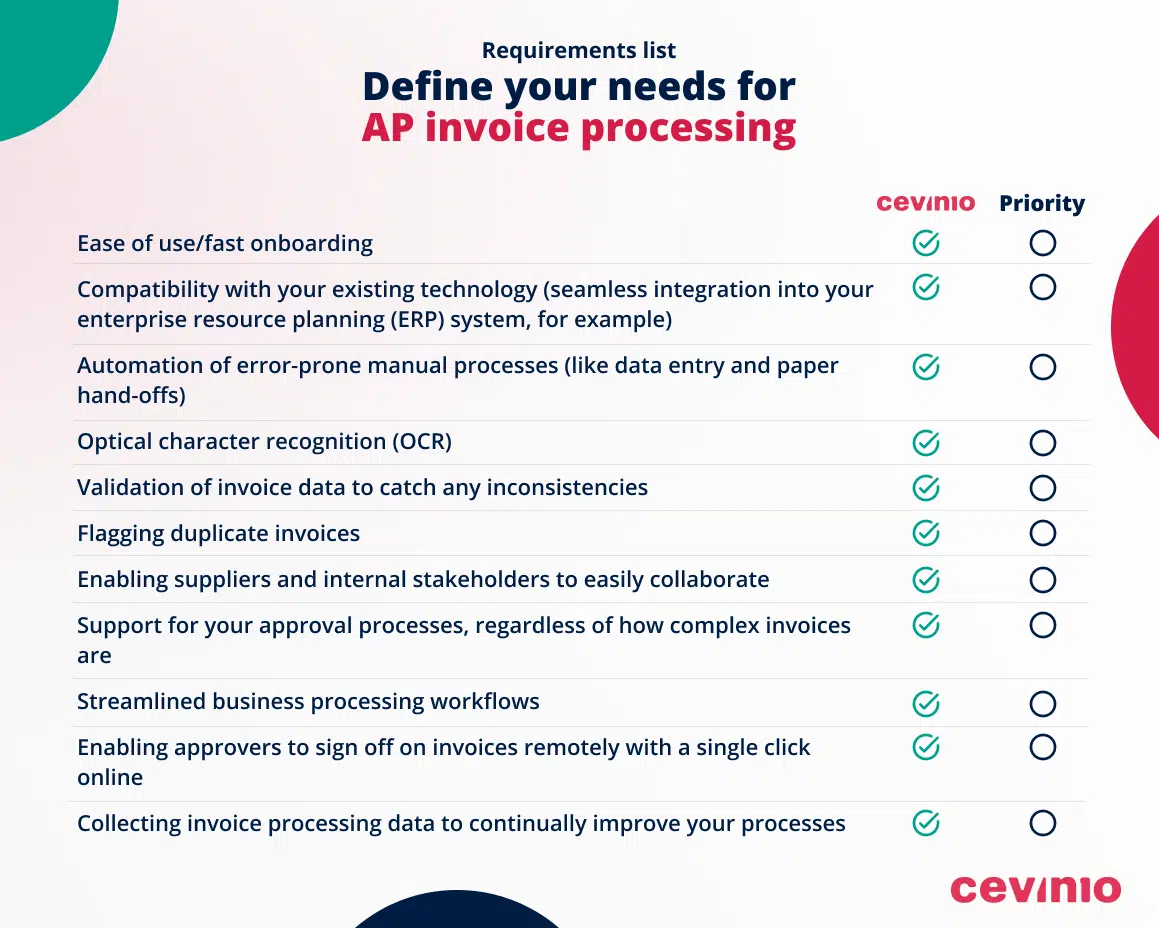
Optimizing the P2P process: the impact of AP Automation beyond Accounts Payable
March 5, 2024
How to select an Accounts Receivable Automation solution
March 21, 2024Quick guide for selecting the best accounts payable tool for your business
For enterprises in all industries, Accounts Payable (AP) automation is a powerful way to increase efficiency, reduce errors and significantly optimize costs.
Without AP automation, your company is exposed to many risks, including:
- higher invoice processing expenses
- greater susceptibility to fraud and errors
- compliance risks
- duplicate and overdue payments
- dissatisfied vendors
AP automation helps you turn these challenges into opportunities. It optimizes your invoice processing and promotes seamless collaboration among stakeholders and vendors.
When choosing an automated AP solution, you want to ensure that you are investing your time and capital as effectively as possible. With so many AP automation providers to choose from, it is challenging to find the best solution for reaching your desired outcomes.
Our quick step-by-step guide below walks you through all the factors to help you find the AP solution that adds the most value to your business.
Step-by-step guide to selecting the best AP solution
To simplify your decision-making process, let’s break down the key steps that we recommend to any enterprise searching for the ideal AP automation software.
1. Create a project team
AP is a process that affects your entire company. So, it is important to take a holistic project management approach.
Start by assembling a team of diverse stakeholders from across your organization. Listening to their suggestions and concerns at every step of the process will help you identify potential challenges and considerations that you might have overlooked.
As a minimum, be sure to include stakeholders from your company who are responsible for Finance/Accounting, Procurement, Operations, IT, Strategy and Finance Transformation. Plan to meet regularly with this project team throughout the decision-making process, as well as during and after the implementation of the AP solution you choose.
2. Define your AP business goals
Working with your project team, define the business goals you want to achieve by implementing a new AP automation solution.
Start by mapping out your existing AP process and identifying its shortcomings. Where are the bottlenecks and gaps that you and your project team would like to eliminate? How do you envision automation helping you to achieve better outcomes?
Common goals for switching to automated AP include:
- Increasing efficiency and simplifying your process
- Boosting productivity
- Saving time and money
- Reducing or eliminating use of paper documents
- Capturing AP data automatically (eliminating manual data entry)
- Speeding up AP processing and ensuring on-time payments
- Streamlining your approval process
- Easy monitoring for invoice statuses
- Simplified reporting (for example, in case of a tax audit)
3. Define your AP needs
In addition to setting goals, define the requirements your AP solution must fulfill. List out all the functionalities that the ideal AP automation solution must offer. Important requirements to consider include:
4. Research vendors and narrow your search
Next, thoroughly research available solutions and create a shortlist of potential vendors that can help you meet your requirements and goals.
In addition to costs, consider factors like:
- Integration capabilities
- Sales and aftersales support quality
- Option for demos, and/or proof of concept
- References
- Industry reports
Once you have identified your favorite potential vendors, you can contact them, or send them a request for information (RFI) to collect more details or a request for proposal (RFP) to learn more about exact costs and how they operate. RFIs help further narrow down potential vendors, while RFPs will give you all the specifics for well-defined projects.
Once you have all the information you need, compare their responses to your questions and requests. The next steps will help you filter your search even further.
5. Compare functionalities and features
Evaluate each vendor’s core AP automation capabilities to ensure they align with the goals and needs you defined in steps 2 and 3 above. Further options to consider include:
- Can the solution import invoices from all different channels you and your vendors use?
- Can it process scanned, PDF and e-invoices?
- Can it split batches into separate invoices?
- Can it identify PO-based invoices?
- Can it perform compliance checks?
- Does it align with your business process workflows?
- Can it automate your invoice approval process?
- Can it automatically process PO and non-PO invoices?
- Does it offer a user-friendly portal for your suppliers to upload their invoices?
At Cevinio, we understand how important and beneficial these features are to our customers. That’s why our AP solution offers all the functionalities listed above, and more.
6. Check integration options
It is also crucial to ensure that the solution you choose can be integrated into your current ERP, accounting software and other business systems. This ensures seamless connectivity and uninterrupted data exchange.
Cevinio, for example, offers a fully integrated solution, which means smooth communication and data synchronization across many different ERP systems.
7. Consider scalability and flexibility
Does the vendor’s solution fit your company’s future goals? Will it allow you to smoothly scale up when you need to process more invoices?
Ask about each vendor’s track record in implementing solutions at your desired scale. Seamless scalability for global operations enables multi-country and multi-language transactions, for example.
8. Review pricing and licensing
Carefully review each vendor's pricing model, including your upfront investment costs, subscription fees, transaction fees and other costs. Short-term costs are always a major factor when making any business decision, but it is also important to consider the long-term return on investment and value added.
9. Assess support and training
Evaluate each vendor’s customer support offering. Ask them about their average response times, knowledge base and available training resources to help ensure you and your company’s employees get the most out of using their software.
Cevinio, for example, offers comprehensive training to ensure our customers quickly adjust to using our software and integrate it into their everyday workflows. This approach helps you start benefiting from our software as fast as possible.
10. Ask for references
Be sure to ask potential vendors to provide references from other companies in your industry. Hearing about other companies’ experiences will give you a clearer view of what it is like to work with the vendor and whether they offer the customer experience you expect.
11. Run a proof of concept
After narrowing your search to the right vendor, the final step is to perform a proof of concept. This is like a pilot project or a test run to see how well the vendor’s software works in real life at your company. Only if the vendor passes this crucial test can you be sure you have made the right choice.
Ready to start your automated AP journey?
The steps above help you identify the best AP automation solution for your business. The key is to work closely with your project team, and to ensure that your buying committee and other stakeholders are engaged throughout the process. Remember that different stakeholders have different priorities. To learn more about how to effectively gain their support and address their needs and concerns, read our article How to choose AP automation software based on your role.
Cevinio offers a comprehensive and scalable AP solution that offers you all the features and benefits described above and more. Our software uses the latest technology in artificial intelligence and RPA technology to boost agent productivity, lower your costs and improve local and global compliance. If you’d like some guidance on discovering whether Cevinio is the best accounts payable automation tool for your business please contact us.





